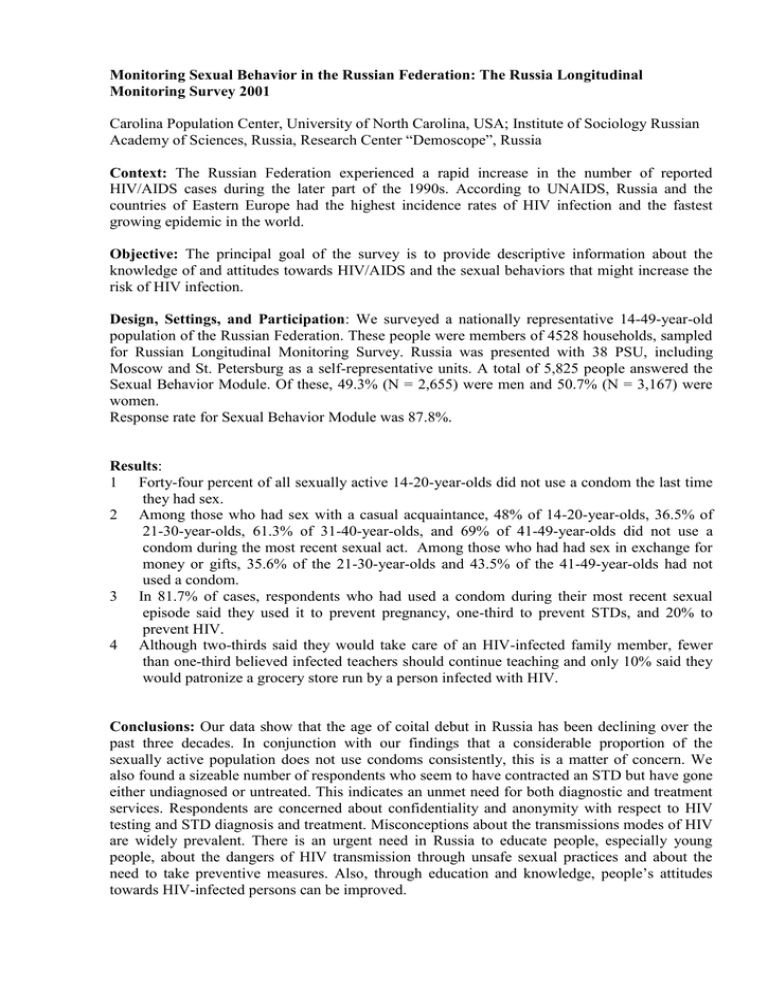
Monitoring Sexual Behavior in the Russian Federation: The Russia Longitudinal
Monitoring Survey 2001
Carolina Population Center, University of North Carolina, USA; Institute of Sociology Russian
Academy of Sciences, Russia, Research Center “Demoscope”, Russia
Context: The Russian Federation experienced a rapid increase in the number of reported
HIV/AIDS cases during the later part of the 1990s. According to UNAIDS, Russia and the
countries of Eastern Europe had the highest incidence rates of HIV infection and the fastest
growing epidemic in the world.
Objective: The principal goal of the survey is to provide descriptive information about the
knowledge of and attitudes towards HIV/AIDS and the sexual behaviors that might increase the
risk of HIV infection.
Design, Settings, and Participation: We surveyed a nationally representative 14-49-year-old
population of the Russian Federation. These people were members of 4528 households, sampled
for Russian Longitudinal Monitoring Survey. Russia was presented with 38 PSU, including
Moscow and St. Petersburg as a self-representative units. A total of 5,825 people answered the
Sexual Behavior Module. Of these, 49.3% (N = 2,655) were men and 50.7% (N = 3,167) were
women.
Response rate for Sexual Behavior Module was 87.8%.
Results:
1 Forty-four percent of all sexually active 14-20-year-olds did not use a condom the last time
they had sex.
2 Among those who had sex with a casual acquaintance, 48% of 14-20-year-olds, 36.5% of
21-30-year-olds, 61.3% of 31-40-year-olds, and 69% of 41-49-year-olds did not use a
condom during the most recent sexual act. Among those who had had sex in exchange for
money or gifts, 35.6% of the 21-30-year-olds and 43.5% of the 41-49-year-olds had not
used a condom.
3 In 81.7% of cases, respondents who had used a condom during their most recent sexual
episode said they used it to prevent pregnancy, one-third to prevent STDs, and 20% to
prevent HIV.
4 Although two-thirds said they would take care of an HIV-infected family member, fewer
than one-third believed infected teachers should continue teaching and only 10% said they
would patronize a grocery store run by a person infected with HIV.
Conclusions: Our data show that the age of coital debut in Russia has been declining over the
past three decades. In conjunction with our findings that a considerable proportion of the
sexually active population does not use condoms consistently, this is a matter of concern. We
also found a sizeable number of respondents who seem to have contracted an STD but have gone
either undiagnosed or untreated. This indicates an unmet need for both diagnostic and treatment
services. Respondents are concerned about confidentiality and anonymity with respect to HIV
testing and STD diagnosis and treatment. Misconceptions about the transmissions modes of HIV
are widely prevalent. There is an urgent need in Russia to educate people, especially young
people, about the dangers of HIV transmission through unsafe sexual practices and about the
need to take preventive measures. Also, through education and knowledge, people’s attitudes
towards HIV-infected persons can be improved.
Ethical Issues:
To achieve a high response rate and fair responses in such a sensitive type of survey the
team developed the sophisticated system to provide confidentiality and preserved human
rights.
Following the general rules of Institutional Review Boards (45 CFR 46.116, 45 CFR
46.117), several Informed Consent forms were designed in which the researches:
1)
Explain the goals of this survey, the importance of studying problem,
2)
Explain the consequences of participating in the survey,
3)
Demonstrate the measures preventing the negative consequences,
4)
Clarify the right to refuse to participate in the survey at the whole, as well as to
refuse to answer any questions
To guarantee confidentiality the self-administrated technique was used instead of usual
face-to-face technique, which was used for all other questionnaires in RLMS.
After the “sexual behavior” questionnaire was filled out, respondents put it into the
special envelope with a stamp of Institute Sociology and sealed it with two stamps for
preventing opening it by anyone.
If respondent wanted, he or she could mail the envelope with filled questionnaire
themselves to the Institute of Sociology directly.
The interviewer was not allowed to leave the questionnaire with the respondents.
The respondent was required to fill in questionnaire at the interviewer’s presence.
However the interviewer was required to seat aside not to see what kind of answers the
respondent was given.
For teens 14-18 years old it was additionally required to get a permission to fill the
questionnaire from their parents or other adults in the household.
At the end of the fieldwork interviewer had to report how many filled questionnaires
were and to return unused (blank) questionnaires, envelopes and stamps.
No personal information is allowed on a hard copy of questionnaire. All IDs information
is being kept separately in a special locked cupboard.
Svetlana Gerasimova, researcher,
Institute of Sociology Russian Academy of Sciences,
Research Center “Demoscope”
2003


